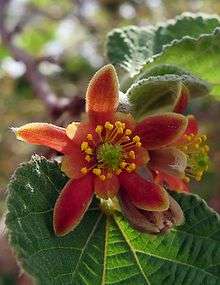Grewia villosa
| Grewia villosa | |
|---|---|
 | |
| Scientific classification | |
| Kingdom: | Plantae |
| (unranked): | Angiosperms |
| (unranked): | Eudicots |
| (unranked): | Rosids |
| Order: | Malvales |
| Family: | Malvaceae |
| Genus: | Grewia |
| Species: | G. villosa |
| Binomial name | |
| Grewia villosa | |
| Synonyms | |
| |
Grewia villosa .This is a shrub, often scrambling and hardly exceeding 4 m in height. Leaves are fairly large, serrated and heart-shaped. It grows naturally, mainly in dry habitats. It is common in most of the semi-arid parts of Eastern Africa but may now be rare in parts of its natural distribution. Seen in Ein Gedi oasis in Israel, common in South Africa. Its ripe copper-coloured fruits are eaten in East Africa.
Uses
The fruit of the Grewia villosa were eaten both while immature and green and also once they had ripened and hardened to a dark, reddish-brown. The bark was stripped off and crushed in water or chewed to a pulp which was used to wash the body as well as to clean the hair and disinfect the scalp [2]
Its wood was used to make a bow of a Cape Verdean musical instrument, the cimboa, traditionally used to be played with the batuque dances.[3]
See also
References
- ↑ http://www.theplantlist.org/tpl/record/kew-2833491
- ↑ G. Miller, Anthony; Morris, Miranda (1988). Plants of Dhofar. Oman: The Sultanate of Oman. p. 284. ISBN 071570808-2.
- ↑ Os Instrumentos Musicais em Cabo Verde [Musical Instruments of Cape Verde] (Brito, Margarida; Centro Cultural Português: Praia – Mindelo, 1998)
- Maundu, P. M. ; Ngugi, G. W. ; Kabuye, C. H. S., 1999. Traditional food plants of Kenya. Kenya Resource Centre for Indigenous Knowledge, National Museums of Kenya, 270 pages
External links
| Wikispecies has information related to Grewia villosa |